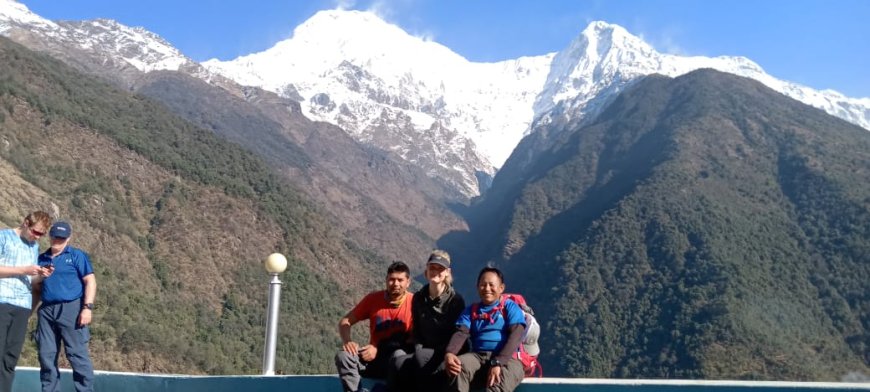When Is The Best Time To Witness The Stunning Annapurna Sunrise?
Discover the best seasons and spots to experience the stunning Annapurna sunrise—perfect timing, clear skies, and serene views for an unforgettable trek.

When Is The Best Time To Witness The Stunning Annapurna Sunrise?
Seeing the sunrise over the Annapurna is virtually one of those things you recollect for your entire life as a trekker, especially in the Annapurna Base Camp Trek. As the first mild pour over the snow-studded peaks, as golden colours and shadows race across the horizon, because the silence of the Himalayas is simply punctuated by the wind, its a stirring, emotional experience. But timing matters. Catching the appropriate sunrise above Annapurna isnt just about waking up early its about choosing the proper season, place, and situations so that it will attain the maximum visibility and atmosphere.
Nepal has two number one hiking seasons spring (March through May) and autumn (September through November) and at the same time as sunrises are possible in all months, not all months come with the same degree of readability, colour, or comfort. Fog, cloud er, and unpredictable mountain weather can all come between you and your once-in-a-lifetime view.
Plus, there's deciding where the best view is, accounting for crowds, and being physically at a place at the right hour, and you'll soon find out planning your Annapurna sunrise is about more than setting an alarm.
Well lead you through the nice instances and locations to stare upon the enduring Annapurna sunrise, and give you a play-through-play on climate phenomenon, crowd control, and the way to stack the deck on your want in terms of clean skies and magical mountain light. Whether or not youre on the way to Poon Hill, Annapurna Base Camp or lesser-recognized spots like Khopra Ridge, timing can flip your morning into something simply memorable.
Why the Best Time for an Annapurna Sunrise Is the Fall
Autumn (September-November) Autumn in Nepal is characterised by incredibly clear, crisp skies, mild temperatures, and reliable weather the perfect recipe for a flawless sunrise! The monsoon is over, and the air is clear with the uninterrupted views of Annapurna I, Machapuchare, and Dhaulagiri. Early morning in fall is the best photogenic crispness and golden ambiance with slightly less moisture and very little cloud cover. Its also peak season, so you can expect to share popular viewpoints with more trekkers, say Poon Hill. But if your aim is the brightest, most reliable sunrises, autumn brings nearly daily dramas around the region.
Blooms and Beauty for Spring Mornings
Spring (MarchMay) is the next best time for sunrises in the Annapurna. You can have a bit greater morning haze than in the autumn, but the rhododendrons will be in bloom, and your sunrise photos may have an introduced pop of shade inside the foreground. The hotter mornings are greater exceptional, especially at higher elevations, and there's increased flora and fauna activity, adding to the charm. For the clearest sunrises, schedule your early hikes to conquer the sun-warming valleys and cause clouds to expand. Spring sees a more subdued, pastel-hued sunrise that is less jarring and edgy but perhaps more lyrical and agreeable.
Stay Out of the Monsoon - June to Aug Struggles
The monsoon season (June-August) is the worst time to see the sunrise over Annapurna. The trails are wet, muddy, visibility is awful, and the creatures are a little prehistoric. Early mornings might still dawn with fog, offering scant glimpses through the windows of the surrounding peaks if you are lucky. Although there are the odd adventurous off-season trekkers who will try, most sunrises are hidden from view. Dont expect reliable mountain views if youre visiting during monsoon. Your best hope would be getting a break in the clouds after the rain for a few moments but thats the exception, not the norm.
Winter Sunrises Cold but Clear Emotions on the Trail
One of the exceptional instances to visit is iciness (December through February), whilst the air is especially dry and humidity is pretty low, making for some of the clearest skies and most dramatic sunrises. You'll probably come across fewer people and greater contrasts among the snow-dusted peaks and the colored sky. However, hiking here isn't smooth. Temperatures drop well under 0, trails can be icy, and high passes like Thorong los angeles or maybe ABC itself are probably closed. If youre accurately organized and experienced for bloodless-weather hiking, winter can offer epic views, in any other case more informal trekkers need to hit lower-altitude vantage points such as Poon Hill or Dhampus.
Poon Hill The Classic Annapurna Sunrise Spot
Poon Hill (three,210m); it's far the most famous sunrise perspective of the Annapurna location. And best a short, pre-dawn hike away from Ghorepani, it serves up a 360-degree landscape of Dhaulagiri, Annapurna South, Machapuchare, and others. wWhichmeans that youre going to must start trekking by means of four, 5 a.m. to get there in time to capture the display. The platform may be quite packed in height season, though, which is not any trouble, as there is a massive viewing area for each person. Come geared up with a headlamp and warm layers, in addition to all the digital camera gear you might want (the golden hour usually kicks off around 5:306:00 a.m. in most seasons). Its touristy, positive, but completely unforgettable as well.
Other Places to Watch the Sunrise for a Quieter Experience
If you are hoping for a crowd-unfastened, serene dawn experience, look somewhere else, including Khopra Ridge, Muldai View point, or Dhampus. [MORE ON ANGKOR WAT: Where the sun never sets, by The Timess Southeast Asia correspondent, Hannah Beech.] those spots have similar and now and then even greater beautiful dawn perspectives, with some distance fewer human beings and a greater real experience. Khopra Ridge affords appropriate perspectives of Annapurna South and Dhaulagiri. Above Ghorepani, Muldai View Point is an ascent to a 360 viewpoint. These choices may require a bit more effort on the hike, but grant you serenity and silence during those mystical sunrise moments a small price to pay for those wishing the keep the tourists at bay.
When would be the best time to trek to Annapurna Base Camp?
The fall (September to November) and spring (March to can also) are the first-rate seasons for the Annapurna Base Camp trek. Those are the seasons wherein the skies are blue, the air is cool, and the climate is dry and settled. In the autumn, you get the clear mountain perspectives after the monsoon, and in the spring, the blooming rhododendrons and riotous colours. Opt for something but monsoon (JuneAugust) and the grim winter months (DecemberFebruary) for protection and visibility.
Is the proper season for the Annapurna Circuit?
Spring also contributes wildflowers and extra mild temperatures. You have to keep away from the monsoon season due to landslides and terrible trail conditions, in addition to wintry weather, when high passes like Thorong la can turn out to be not possible to pass.
What is the best view of the Annapurna Circuit?
The spotlight is the Thorong l. a. bypass 5416m, and it stands because the maximum iconic attitude at the Annapurna Circuit and boasts panoramic views of the whole Himalayan vrange one-of-a-type highlights are Manang, below dramatic mountain peaks, and Poon Hill, for its sunrise perspectives of Dhaulagiri and Annapurna. The alpine landscape of Bheri Pisang and Yak Kharka is, in addition, endearing.
How to prepare for ABC?
For the Preparation of the Annapurna Sanctuary Trek, start schooling 68 weeks in advance by using working up your aerobic endurance (trekking, going for walks, stair climbing) and leg strength. Hike while wearing a backpack, have a look at altitude sickness, and know where you could take acclimatization breaks. Prepare correct warm layers, hiking footwear, and let's go in (ACAP, TIMS). It isn't always simply health, however, but additionally mental preparedness and an adaptable body of mind.































